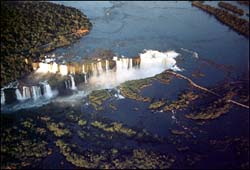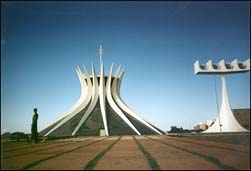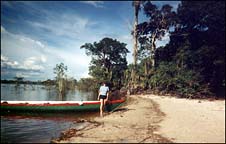Helen Rose's Hill Walking Diary - June 2002
A Walk in Brazil

Recently I spent a few weeks in Brazil which is really too short a time as it is the fifth largest country in the world. There is much to see there from the beaches and style of Rio, the Seventies funky architecture of Brasilia, the indescribable beauty of the Iguassu Falls, the Amazon jungle, the colonial city of Salvador to the sub tropical walking region of Lencois and much, much more.
Although the trip was not a walking tour but mainly sightseeing, I still managed to fit in a day of walking in Lencois. Lencois is in Bahia State in the North East of Brazil and about 250 miles inland from Salvador. Salvador is well worth a visit as it is reputed to be the best example of Portugese Colonial architecture and of course has the magnificent beaches for which Brazil is world famous.
Lencois is an old diamond boom town and nestles in the Chapada Diamantina Massif. The diamond prospectors flocked here in 1844 and some of the diamonds were used in drill bits for excavating the London Underground. Some of the prospecting ruined the countryside as vegetation was burned extensively and areas flooded to flush out the diamonds. The Massif is located in an area surrounded by low scrubland and is an unexpected oasis of luxuriant valleys and hills interspersed with rivers.

Walking is limited by the heat and more so the high humidity which makes the consumption of fairly large quantites of water necessary. We had a morning walk from the town to the Lencois River. There was a good path on the route and we visited caves which were formed by the diamond mining. It was interesting to see the philodendron roots hanging over the caves and down the sheer sandstone rock and quartz walls. There was colour on the rock from the iron oxide deposits and the floor of the caves were sand formed from the water flooding the area during prospecting. The geology of this is that the land pushes up fissures into which the water is jetted to allow prospecting. This has been detrimental to the ecology of the area with very little indigenous wild life left and the loss of some species of plants and trees.
Along the route we passed a seious of waterfalls with various rock pools where swimming was possible. The vegetation was lush but the path was kept clear and easy to walk although there was a little minor scrambling up rocks but with plenty of trees to hold onto. The mining in the area stopped in 1888 when slavery was abolished and the economy slumped due partly to the emergence of South Africa as a producer of superior diamonds.
In the afternoon, we drove to Pai Imacio and climbed to the top of a mesa 1,150 metres above sea level for a view of the wooded Chapada Diamantina Massif and the rocky outcrops. The area is a National Park and there are many walking trails in it of varying lengths but unfortunately there is little investment in the Park. It is perhaps an area waiting to be discovered as most tourists to Brazil will not venture beyond the main sights of Rio, Salvador, Iguassu and the Amazon. When stopping for a cold drink we saw Mico monkeys in a tree. They are very small with sweet faces and were looking for food but feeding wild life is discouraged as they get into bad habits!.

The time in Lencois was very enjoyable and a wander around the town was worthwhile to see the Portugese Colonial architecture with the buildings painted contrasting bright colours. The town setting is beautiful surrounded by lush green vegetation with a river running over rocks through the centre of the town. The people were very friendly and I did not feel under threat at all walking around on my own. Sadly, the crime rate in Brazilian cities is high and tourists are warned not to carry any valuables around.
I had initially been attracted to Brazil to see the Iguassu Falls and the Amazon Jungle but Lencoiis was a little gem which I am very pleased to have visited and I would recommend it to anyone visiting Brazil. However, the Iguassu Falls are wonderful and have to be seen to be believed. Some stunnung statistics are; the Falls are 3 kilometres long with 250 separate falls, 800 metres at the widest point and the water falls at a rate of 2,000 square cubic meters per second. Impressive! Even more so than seen in the film 'The Mission'.
Coming attraction. Walking in the North of Ireland
E mail me at [email protected] with all your comments.
Thanks to Frances Rickus for the photographs







